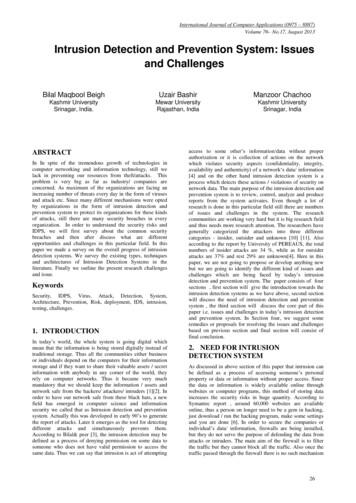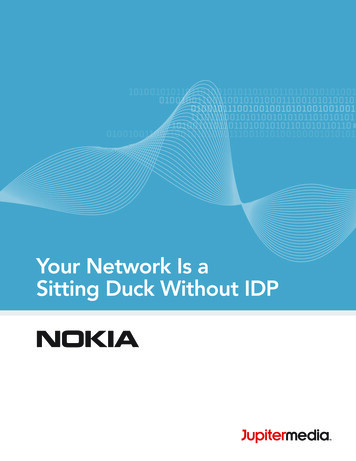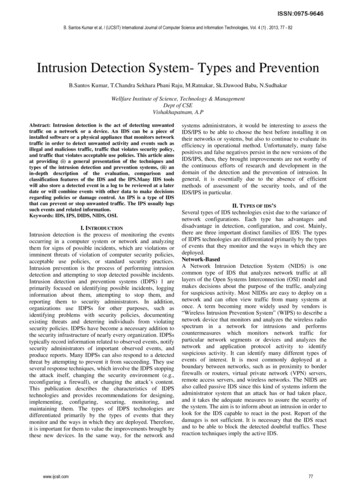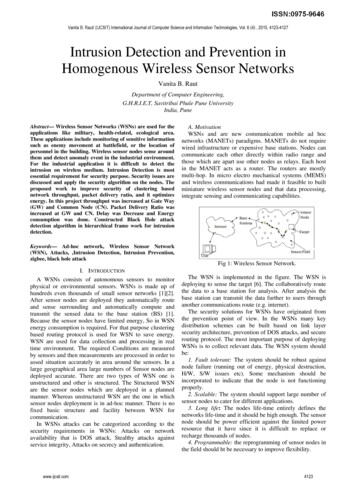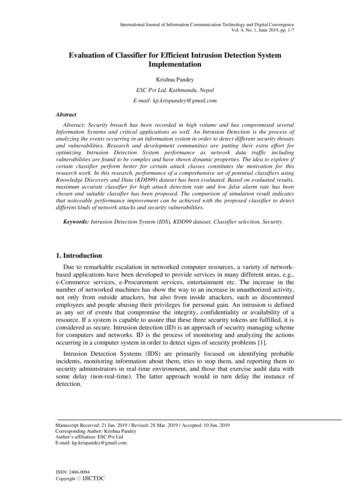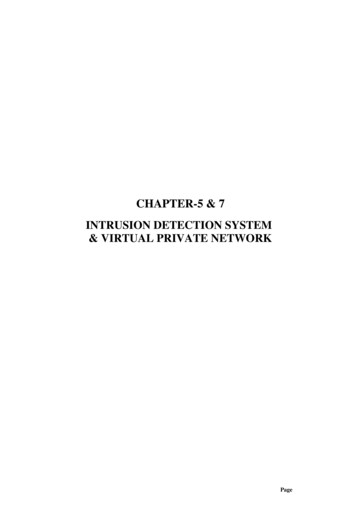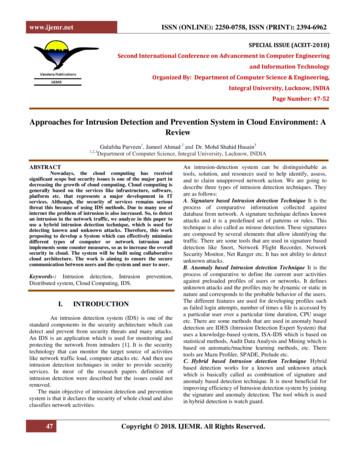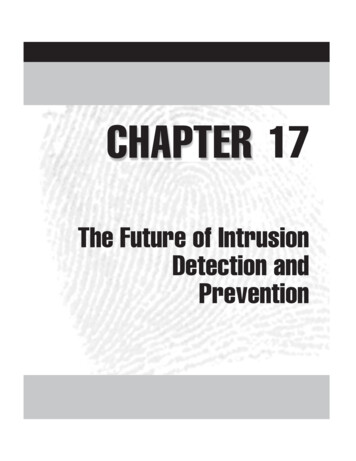
Transcription
Incident/ IntrusionColor profile: HackingGeneric CMYKprinterprofileComposite Default screenDetection & Prevention / Endorf, Schultz, Mellander / 222954-3 / Chapter 17 Blind Folio 345CHAPTER 17The Future of IntrusionDetection nday, December 01, 2003 12:08:59 PM
HackingIncidentColor profile: Generic CMYK printerprofileComposite Default screen346/ Intrusion Detection & Prevention / Endorf, Schultz, Mellander / 222954-3 / Chapter 17Intrusion Detection & Preventions mentioned in previous chapters, many changes are in store for intrusion detection and intrusion prevention. Some of these changes could actually be negative—at least from the perspective of intrusion detection. For example, the GartnerGroup, a technology research and consulting organization, asserts that IDSs will soon berelics of the past. Gartner says that IDSs have not established themselves in the IT marketplace, that they produce too low a return on investment (ROI) for all the resourcesexpended, and that excessive false alarms and misses have greatly impaired their usefulness. Gartner predicts that intrusion prevention technology will prevail in the belief thatshutting off intrusions altogether is better than allowing intrusions to occur and just monitoring them. Accordingly, Gartner recommends that IT organizations turn to firewalls,not IDSs. Many IT security experts denounced Gartner’s prediction, though, saying thatGartner does not really understand how intrusion detection fits in with a layered defenseapproach (of which many believe that intrusion detection is a critical part) and that intrusion detection technology is still growing and improving.Regardless of whatever sliver of truth there may or may not be in Gartner’s prediction, two things are certain—intrusion detection is still a long way from being mature,and intrusion prevention technology is in its infancy. Massive changes are in store forboth areas. This chapter focuses on some of the areas within intrusion detection and intrusion prevention in which substantial and beneficial progress is likely to occur. Theseareas include the following:A The continued reduction in reliance on signatures in intrusion detection The growth of intrusion prevention Advances in data correlation and alert correlation methods Advances in source determination Inclusion of integrated forensics functionality in IDSs and IPSs Greater use of honeypotsWe’ll begin by considering why signature-based intrusion detection will become lessmainstream in the future.LOWER RELIANCE ON SIGNATURE-BASEDINTRUSION DETECTIONThe signature approach to intrusion detection, which traces back to the early 1990s, represents a major advance over the previous statistical-based approaches of the 1980s. Signatures are not only a relatively straightforward and intuitive approach to intrusiondetection, but they are also efficient—often a set of only a few hundred signatures canresult in reasonably high detection rates (albeit often at the cost of false alarm rates, asdiscussed earlier). Signature-based IDSs have proven popular and useful, so much sothat you can count of some of these tools being available for a long time.P:\010Comp\Hacking\954-3\ch17.vpMonday, December 01, 2003 12:08:59 PM
HackingIncidentColor profile: Generic CMYK printerprofileComposite Default screen/ Intrusion Detection & Prevention / Endorf, Schultz, Mellander / 222954-3 / Chapter 17Chapter 17:The Future of Intrusion Detection and PreventionSignature-based intrusion detection is beset with numerous limitations, however,including the following: Because attacks have to occur before their signatures can be identified, signaturescannot be used in discovering new attacks. The “white hat” community is thusalways one step behind the “black hat” community when it comes to newattack signatures. Many signatures in IDSs are badly outdated. One commercial IDS for manyyears contained the signature for a Unix exploit in which an attacker couldenter the rlogin command with the –froot switch to obtain a root shellon a victim system. This exploit was for early versions of the AIX operatingsystem, versions almost never used anymore. You can always “weed out”obsolete signatures, but doing so requires a reasonable amount of unnecessaryeffort; good IDS vendors do not include such signatures in their products’signature sets in the first place. Some attacks do not have single distinguishing signatures, but rather a widerange of possible variations. Each variation could conceivably be incorporatedinto a signature set, but doing so inflates the number of signatures, potentiallyhurting IDS performance. Additionally, keeping up with each possible variationis for all practical purposes an impossible task. Signatures are almost useless in network-based IDSs when network trafficis encrypted. The black hat community is becoming increasingly better in evadingsignature-based IDSs, as discussed in the sidebar “IDS Evasion Tools.”IDS Evasion ToolsThe number of methods for evading signature-based IDSs has been increasing dramatically over the last few years. For example, powerful tools that can defeat signature-based IDSs are available. One class of tools (such as Fragroute) launches"insertion attacks,” in which malicious commands sent to a server are disguised byinserting extra, bogus data. When the IDS processes the traffic in which these commands are embedded, the IDS does not recognize anything as an attack signature,but when the destination server processes the input it receives, it discards the extradata, allowing the commands to execute.For example, an attacker can send the following command to a web server:GET //cgi-bin//some.cgi.The web server cannot recognize some.cgi, so it may discard this part of theinput, connecting the attacker to cgi-bin instead. Unfortunately, cgi-bin is theP:\010Comp\Hacking\954-3\ch17.vpMonday, December 01, 2003 12:08:59 PM347
HackingIncidentColor profile: Generic CMYK printerprofileComposite Default screen348/ Intrusion Detection & Prevention / Endorf, Schultz, Mellander / 222954-3 / Chapter 17Intrusion Detection & PreventionIDS Evasion Tools (continued)directory for common gateway interface scripts, one of the places just about everyweb hacker wants to be.Another trick is to insert a premature null character:GET%00 /cgi-bin/some.cgi HTTP/1.0Alternatively, an attacker can send ASCII-coded input that invokes a maliciouscommand to an interpreter:perpetrator@host perl –e' bad );@hack '/bin/cat/ bad'; print"@hack\n";’Another evasion method is rexmit inconsistency. An attacker sends a TCPstream in which some of the data within the stream is garbled. The receiving host(intended victim) sends a message to the sending host (the attacking host) asking itto retransmit. The sending host then sends malicious commands. The IDS analyzesthe first stream and determines that it does not match any attack signatures. However, for efficiency’s sake, the IDS may not analyze the second stream (which in theory should be identical to the original one), resulting in a missed attack. Many otherevasion techniques work against signature-based IDSs, too. IDS evasion techniquesdo not exclusively target signature-based IDSs, however. There are evasion techniques for rule-based IDSs, too, for example.If reliance on signatures in intrusion detection will dwindle in the future, what intrusion detection methods are likely to become increasing important? Several alternativesdiscussed in the next section appear probable.Protocol AnalysisProtocol analysis means analyzing the behavior of protocols to determine whether onehost is communicating normally with another. For example, the TCP handshake (discussed in Chapter 2) is initiated by sending a TCP SYN packet to another host. The otherhost responds with a SYN ACK packet, to which the originating host responds with anACK packet. Suppose that a host sends nothing but SYN packets to another host—an indication of a “SYN flood” attack designed to deplete memory and other resources in thereceiving host. In another kind of protocol attack, a host might send malformed IP packets, perhaps IP packets in which one or more values in the IP header is out of range. In stillanother, a malicious code may send malformed “chunks,” parcels in which data aretransferred from a browser to a web server to provide an orderly way for the web serverto encode the input.P:\010Comp\Hacking\954-3\ch17.vpMonday, December 01, 2003 12:08:59 PM
HackingIncidentColor profile: Generic CMYK printerprofileComposite Default screen/ Intrusion Detection & Prevention / Endorf, Schultz, Mellander / 222954-3 / Chapter 17Chapter 17:The Future of Intrusion Detection and PreventionAlthough these are simple examples, protocol analysis is by no means any kind of“lightweight” way of performing intrusion detection. A wide range of attacks (particularlyDoS attacks) can be detected in terms of anomalous protocol behavior. Identifiable signatures may exist for many of the same attacks, but identifying these attacks at a lower level ofnetworking (such as the network or transport layer by looking at the behavior of protocolssuch as IP, TCP, UDP, and ICMP) is more efficient than having to go to a higher layer. Therules of normal protocol behavior are well defined in RFCs (see www.ietf.com/rfc.html),so deviation is usually (but by no means always, given that a certain percentage of networktraffic does not behave in accordance with any RFC) rather straightforward to determine.Additionally, many attacks that would require literally scores of signatures to detect can often be identified in terms of only a very few protocol behavior irregularities. Many of today’s IDSs perform protocol analysis; IDSs of the future are likely to do more and also doit better.Target DetectionWe’re also likely to see more widespread use of target detection in the future. As mentioned previously, target detection has proven to be one of the most robust and reliablemethods of intrusion detection. Attackers almost invariably make changes in systems, often to create back doors, but sometimes (especially in the case of novice attackers)changes occur simply by accident. Attackers may be able to evade signature-based IDSs,and they may also be able to delete system logs to hide evidence of their activity, but theyare less likely to escape the notice of a target detection tool that uses a variety of strongcryptographic algorithms and requires strong authentication for access to the target detection functions.Although commercial target detection tools such as Tripwire (http://www.tripwiresecurity.com/) and Intruder Alert roducts.cfm?ProductID 171) are widely used within Fortune 500 companies,the price of deploying these tools on many systems often serves as a deterrent to their usein smaller organizations. Freeware versions of Tripwire (http://ftp.cerias.purdue.edu/pub/tools/unix/ids/ tripwire/) and Windows-based integrity checking tools such asForixNT (http://www.incident-response.org/forix-nt.htm) are available, but hurdlessuch as worries over software support have at least to some degree inhibited their widespread use.Commercial target detection tools have established themselves in the marketplace;they will not disappear any time in the near future. What is likely to happen, however, isthat operating system and application vendors will build powerful integrity checking capabilities into their products. To at least some degree, vendors already do this. Unix vendors, for example, have for a long time included the sum command for computing simplecryptochecksums and the diff command for detecting changes in file contents.Microsoft also includes the System File Checker and Windows File Protection in many ofits operating system products. But these capabilities are relatively crude compared to thecapabilities of many commercial tools.Vendors are likely in time to expand the scope of integrity checking programs to include more than simply device driver or system file checking capabilities and also to pro-P:\010Comp\Hacking\954-3\ch17.vpMonday, December 01, 2003 12:09:00 PM349
HackingIncidentColor profile: Generic CMYK printerprofileComposite Default screen350/ Intrusion Detection & Prevention / Endorf, Schultz, Mellander / 222954-3 / Chapter 17Intrusion Detection & Preventionvide real-time alerting capabilities. It would not be surprising, for example, to learnsometime in the near future that one or more vendors had incorporated the commercialTripwire tool into an operating system. Doing this would make target detection easier tomanage and possibly also more secure, given that operating system defenses could alsobe used to protect target detection executables and data files.In the past generation (and in all likelihood, the future) of kernel-based Unix exploits, the existence ofchanges to the file system has almost always been well hidden from system administrators and users.An example is the sk Linux rootkit, which initially was found in systems only because of numerous implementation bugs. Ultimately, kernel-based exploits are the greatest threat to target-based IDSs, inwhich detection depends on subtle changes in the behavior of the system.Rule-Based Intrusion DetectionRule-based intrusion detection is more of an eclectic approach than the other alternativesto signature-based intrusion detection covered in this section. In this approach, logic conditions based on possible incident-related observations are defined. Observations couldbe signatures, irregularities in protocol behavior, unusual system events, changes in filesand/or directories, and so on. Rule-based intrusion detection analyzes elements derivedfrom these observations and then uses logic to identify attacks. For example, suppose thatelement A is defined as a probe from a certain IP address, that B is defined as attemptedaccess via anonymous FTP, and that C is defined as an attempt to obtain the passwordfile. If A or the combination of B and C occur, this could be defined as an attack pattern.Rule-based intrusion detection is used in a number of IDSs today, especially prototype systems used in connection with intrusion-detection research. The rule-based approach is potentially more powerful than signature-based intrusion detection because itrelies on multiple variables/indicators—events based on signatures, protocol analysis,target detection indicators, and so on. Because this approach seldom equates a singleevent with a rule, it is likely to produce a higher hit and lower false alarm rate than signature-based intrusion detection. The higher hit rate is particularly significant. An attack may manifest itself in multiple but nondeterministic ways; rule-based intrusiondetection can define long strings of “or” rules, one of which might apply to a particularset of observations, enabling it to detect attacks that simple signature-based IDSs mightvery well miss.The main limitation of rule-based intrusion detection is the potential complexity associated with all the rules that are normally created. Only those with advanced technicalskills and knowledge are likely to be able to understand the rules in the first place. It generally is difficult to create rules (which can often involve many steps of logic) and also tomaintain rules (for example, weeding out obsolete rules). Processing the rules themselvescan also cause massive CPU and memory utilization in the host that houses a rule-basedintrusion detection system. Still, rule-based intrusion detection represents a significantadvance over simple signature-based intrusion detection; it is likely to be used increasingly over time.P:\010Comp\Hacking\954-3\ch17.vpMonday, December 01, 2003 12:09:00 PM
HackingIncidentColor profile: Generic CMYK printerprofileComposite Default screen/ Intrusion Detection & Prevention / Endorf, Schultz, Mellander / 222954-3 / Chapter 17Chapter 17:The Future of Intrusion Detection and PreventionRule-Based Intrusion DetectionRule-based intrusion detection can involve long sets of complex rules, somethingthat may make this approach seem nebulous and impractical. Rules can, however,be as simple as needed. The tcpdump tool discussed in Chapter 5 provides analmost ideal example how rules can be created at the protocol level. Consider, forexample, the following tcpdump expression:(tcp src port 27374 ) and ( tcp[2] 3 )) or ((tcp dst port 27374)and (tcp[0] 3))This expression represents a rather simple rule—the source port must be TCP27374 and the 2nd byte of the TCP header (destination port) must be at least 4 256or 1024 OR the destination port must be TCP 27374 and the 0th byte of the TCPheader (source port) must be at least 4 256 or 1024. A rule-based intrusion detectionsystem could include and use this type of rule to detect the presence of the deadlySubSeven Trojan horse remote control program in Windows systems. If there is aconnection from port 27374, the most used port in connection with this particularTrojan, to an ephemeral port or a connection to port 27374 from an ephemeral port,the IDS would in this example report an attack.Neural NetworksNeural networks are systems that perform pattern recognition on inputs they receivebased on models of how neurons in mammals process information. Neurons are nervecells; they are densely interconnected and interface with each other at synapses, smallgaps between individual neurons. They also work in parallel to other neurons at anygiven level of brain structure. Neural networks are sets of mathematical models that imitate how neurons learn, assigning different weights to connections between elementswithin the neural network similarly to how electrical potentials for neurons are built upat synaptic junctions based on their frequency of firing. The more frequently a neighboring neuron fires, the more electrical potential there is at the synapses of the neurons thatreact to this pattern. In neural networks, elements that receive inputs from neighboringelements receive higher weights.Although complicated and still somewhat mysterious, the neural networks approachcan be applied to a wide range of pattern recognition problems, intrusion detectionincluded. The beauty of neural networks in intrusion detection is that no signatures oreven rules are needed. You simply start feeding input—data concerning network- orhost-based events—to a neural network, and it does the rest. Neural networks are, therefore, well suited to picking up new patterns of attacks readily, although some learningtime is required. The neural networks approach has been around for a long time, and ifP:\010Comp\Hacking\954-3\ch17.vpMonday, December 01, 2003 12:09:00 PM351
HackingIncidentColor profile: Generic CMYK printerprofileComposite Default screen352/ Intrusion Detection & Prevention / Endorf, Schultz, Mellander / 222954-3 / Chapter 17Intrusion Detection & Preventionanything it is likely to become more widely used and relied on in intrusion detection inthe future as reliance on signatures diminishes.INTRUSION PREVENTIONIntrusion prevention is another area that will grow dramatically in the future. Intrusionprevention is in its infancy. Anyone who thinks that IPSs and IDSs are diametrically opposed or that IPSs will eventually supplant IDSs is badly mistaken, however. An IDS islike a burglar alarm, something that provides information about past and ongoing activity that facilitates risk and threat assessment as well as investigations of suspicious andpossibly wrongful activity. IPSs are designed to be defensive measures that stop or atleast limit the negative consequences of attacks on systems and networks, not to yield thewealth of information that IDSs typically deliver.The number of potential, useful variations in “intrusion prevention” is mind-boggling. Consider, for example, the first type of intrusion prevention used in connectionwith intrusion detection—shunning. Shunning is a mainstay feature in today’s IDSs, yetshunning is, all things considered, a rather crude way of performing intrusion prevention. In all likelihood, malicious packets will already have arrived at the intended victimhost by the time any firewall or router ACLs are changed to block future packets from theapparent attacking host—not exactly the desired results if shutting off the attack in thefirst place is the goal.IPSs such as Cisco’s Okena StormSystem product (see https://www.okena.com/pdf/stormwatch datasheet.pdf) represent another extreme in the intrusion preventioncontinuum in that a number of hosts can be spared from having to suffer the maliciousconsequences of an attack because they have received a policy change based on detectedmalicious activity on the network. Others view intrusion prevention in terms of a set ofinterrelated (and very possibly cooperating) devices and capabilities that work togetherto diagnose system and network events and shut off incidents at any point where theycan be shut off.One of the major, new offshoots of the last permutation of intrusion prevention discussed here is called “active defense” (as opposed to “passive defense,” such as passivelymonitoring systems and networks and deploying static access control lists [ACLs] inrouters and firewalls). Active defense means analyzing the condition of systems and networks and doing what is appropriate to deal with whatever is wrong. According to DaveDittrich of the University of Washington, there are four levels of active defense: Local data collection, analysis, and blocking Remote collection of external data Remote collection of internal data Remote data alteration, attack suppression, and Monday, December 01, 2003 12:09:00 PM
HackingIncidentColor profile: Generic CMYK printerprofileComposite Default screen/ Intrusion Detection & Prevention / Endorf, Schultz, Mellander / 222954-3 / Chapter 17Chapter 17:The Future of Intrusion Detection and PreventionFigure 17-1 portrays one possible active defense architecture. Numerous hosts withina hypothetical network collect intrusion detection data and send them to a central analyzer that, whenever appropriate, sends policy changes to individual hosts to keep themfrom executing certain instructions in memory, changing the content of certain files, andso forth. The external firewall, the outermost layer in the active defense infrastructure,detects relatively straightforward attacks such as SYN flooding attacks and shuns offending IP addresses immediately. A network-based IDS within this network gathers information from sensors at the external gateway and at entrances to several subsets; it sendsACLs changes to the firewall and data to the central analyzer on the basis of attack patterns that it deciphers.One of the most important (and controversial) facets of the active defense approach tointrusion prevention is determining the appropriate response. The notion of appropriateresponse includes a consideration called “ proportionality of response,” which ensuresthat the response is proportional to the threat. In the case of a host that is flooding a network with fragmented packets, blocking traffic sent from that host is almost certainly theCentral analyzerHost IDSInternetFirewallHost IDSNetwork IDSFigure 17-1.A simple active defense , December 01, 2003 12:09:00 PM353
HackingIncidentColor profile: Generic CMYK printerprofileComposite Default screen354/ Intrusion Detection & Prevention / Endorf, Schultz, Mellander / 222954-3 / Chapter 17Intrusion Detection & Preventionmost appropriate response. If several dozen hosts known to be operated by an ISP repeatedly attack an organization’s network, blocking all the traffic from the range of IP addresses owned by that ISP might be the most appropriate response. Some advocates ofthe active defense approach even believe that if a remote host is repeatedly attacking anorganization’s network, counterattacking that host, perhaps by flooding it with fragmented packets, thereby causing it to crash, is the appropriate course of action. Many, theauthors of this book included, strongly disagree with the notion of counterattacking,however, as discussed in the “Striking Back” sidebar.Although intrusion prevention appears promising, (as mentioned) it is very much inits infancy. Attack stave-off rates for intrusion prevention systems are nowhere as high asthey need to pose a major deterrent to attacks. Additionally, false alarms can easily causewhat effectively amounts to DoS within individual systems. Intrusion prevention systems of the future are likely to be able to prevent a wider range of attacks, not only at thelevel of the individual host, but also within organizations’ networks and possibly evenwithin the Internet itself. The last possibility is particularly intriguing. Perhaps some organization such as the U.S. government’s federal incident response team, FedCIRT, willcontinuously monitor all traffic bound for U.S. government sites and stop selectively malicious packets long before they reach the gateways of the government sites for whichthey are destined.Striking Back“Striking back” has recently been a hot topic within information security and otherdiscussion groups. Some advocate doing whatever is necessary to prevent attacksfrom a known source of trouble. In some cases this would mean causing DoS in theoffending host; in other cases, it might mean destroying the offending host altogether by breaking into the host and then erasing critical system files. The lack ofsufficiently strong cybercrime legislation throughout the world makes this approach more attractive to its advocates; some individuals even think that it is important to teach attackers a lesson by letting them “have a taste of their ownmedicine.”Striking back has raised a plethora of ethical controversies, so many that at thispoint in time, the information security community as a whole is firmly opposed toit. Striking back is also illegal in numerous countries around the world. But in themilitary arena, striking back could well be the appropriate course of action—an important countermeasure in information warfare. If, for example, an opposing military force were causing DoS in systems used for military intelligence analysis,shutting out the source of the attacks would make perfect sense. The striking backissue is likely to grow in connection with the active defense approach to intrusionprevention over time.P:\010Comp\Hacking\954-3\ch17.vpMonday, December 01, 2003 12:09:01 PM
HackingIncidentColor profile: Generic CMYK printerprofileComposite Default screen/ Intrusion Detection & Prevention / Endorf, Schultz, Mellander / 222954-3 / Chapter 17Chapter 17:The Future of Intrusion Detection and PreventionStriking Back (continued)But striking back is dangerous, especially from a legal aspect. Anyone who considers deploying strike-back methods should at a minimum obtain management’sapproval and also (if management approves striking back) consult one’s legal department before proceeding. Remember at the same time that you may end up getting sued by the individual or organization whose host you attacked, even if youhave management approval.DATA AND ALERT CORRELATIONAs mentioned in Chapter 12, data correlation is becoming increasingly important. IDSs,IPSs, firewalls, personal firewalls, and TCP wrappers are each capable of generating largeamounts of data; collectively, they are capable of overwhelming intrusion detection analysts with data. Data aggregation helps ensure that data are available in a single location;data correlation enables analysts to recognize patterns in these data. Although currentdata correlation methods are for the most part not very sophisticated, future data correlation is likely to become much better. How will data correlation algorithms need tochange? Waltz and Llinas (in Multisensor Data Fusion, Boston: Artech House, 1990) havedeveloped criteria for systems designed to fuse data must be able to, saying that thesesystems must be able to do the following: Distinguish parameters of interest (hit rate, range of events detected, and so on)from noise Distinguish among different objects in space and time Adequately track and capture each desired type of event and data Sample the data and events of interest with sufficient frequency Provide accurate measurements Ensure that each variable that is measured adequately represents the desiredtypes of categories Provide access to both raw and correlated data Preserve the temporal characteristics of data and eventsIt is unlikely that all systems designed to fuse data will meet every one of these requirements. The more of these requirements that a system meets, however, the more useful indata fusion/correlation it is likely to be. Currently, one of the greatest barriers to automated data fusion has been the lack of a common format for data from intrusion detectionsystems. Although common formats have been proposed, little agreement has resulted.Agreement upon a single data format would thus constitute a giant step forward.P:\010Comp\Hacking\954-3\ch17.vpMonday, December 01, 2003 12:09:01 PM355
HackingIncidentColor profile: Generic CMYK printerprofileComposite Default screen356/ Intrusion Detection & Prevention / Endorf, Schultz, Mellander / 222954-3 / Chapter 17Intrusion Detection & PreventionAdditionally, user interfaces of applications that perform data correlation are likely toimprove dramatically in the future. Deficits in the usability of software used in data correlation are by no means unique; usability problems plague the information securityarena as a whole. Human-computer interaction methods for controlling what is displayed tend to be nonintuitive and excessively complex. Data displays are often clutteredto the point of being overwhelming to view; few options for data reduction o
Gartner predicts that intrusion prevention technology will prevail in the belief that . (albeit often at the cost of false alarm rates, as . changes to the file system has almost always been well hidden from system administrators and users. Intrusion Detection & Prevention Hacking Incident / Intrusion Detection & Prevention / Endorf .

